#and P&P screencap is green and yellow/orange
Text
WIP




There’s always that point in my painting process where colour fun turns to value/hue accuracy hell and I’m currently experiencing that right now
#dusk fan art#WIP#It’s just. initially I eyeballed colours from the Pride & Prejudice screencaps right#(painted the top one last night#BUT Bingley is white and Kaeya is a POC so I can’t use Bingley’s skin tone as ref for Kaeya#but the VALUES of the P&P screencap is really nice so I wanted to keep that#so I found a screencap from The Witcher Netflix#which I know has lots of POC characters (good ref for Kaeya’s skin tone)#and last night I didn’t like the first one’s colours ‘cause I associate Dawn Winery with blue and red#well. blue and red/orange#and P&P screencap is green and yellow/orange#looked at the Witcher screencap and shifted the hues all together#focused a lot on painting Kaeya’s skin with that woman on the right as ref#now everything else looks underpainted#do I want to render Diluc’s face and both their hair too#man.#what an experience. I enjoyed it a lot#Genshin impact#pride and prejudice#the witcher netflix
6 notes
·
View notes
Text
Current Requests!
If you see your ask on here and anything seems off, just shoot me another ask!
Moodboard for Barbary lion, gold/honey/wings/angelcore/sphinxes/knowing better than most themes
Moodboard for Wally Darling (Welcome Home) ramen/kidcore/dinosaur play rooms/coca-cola themes
Moodboard for One-One (Infinity Train) cottagecore/flower fields themes
Userbox/Banner for Laios (Dungeon Meshi) woolly mammoth themes, which says 'This user is otherhearted with prehistoric animals!'
Userbox/Banner, abandoned waterpark/swamp/theme park themes, which says 'This user feels a strong connection to animatronics, especially when they start to decay.'
Typing Quirks for cold/frozen/glitch themes
Shipboard for Miles Edgeworth (Ace Attorney) and S/I, Emily, master/servant/orange cats/light academia/dubcon themes
Playlist for Vaggie (Hazbin Hotel) x wolf!woman!Significant Other, with nightcore/angel themes
Fashion for Vaggie (Hazbin Hotel) angelcore/red/pink themes
Shufflemancy for the following question: 'Huskerdust in FNAF AU?'
Moodboard for Katrina (Disney's Legend of Sleepy Hollow)
Moodboard for Kate Marsh (Life is Strange) bunnies/crosses/drawings/violins themes
Pokemon Team for Max and Chloe (Life is Strange)
Collage for Alexander (Pinocchio) and Princess Eilonwy (The Black Cauldron)
Collage for Lampwick (Pinocchio) and Tiger Lily (Peter Pan) young love/pink hearts themes
Shipboard for Fred and Spike (Buffy the Vampire Slayer) Take me to Heaven by Sleeping Wolf/touching for the first time/hand holding/physical affection/some lyrics themes
Shipboard for Ill and Halyn (Alters) strange love/obsessive love/swamps/love leading to death/owls themes
Platonic moodboard for female!shiny!buneary and female!shiny!charmander (Pokemon) loyalty/orange/purple themes
Selfshipboard for Beetlejuice (any source, more musical) x young teen self insert, cat/grooming/codependency/manipulation/stalking themes
Stimboard for Sunchase (Warriors OC) no fur/hands themes
Moodboard for Mallow (Pokemon OC) porcelain/daisies/forget-me-nots/slight ns/fw/no text themes
Shipboard for Umbreon and Espeon (Pokemon) romance/soulmates themes
Shipboard for Hephaestus (Hades 2) and Goddess Self Insert, godhood/plotting revenge/supporting partner with disabilities/supporting partner with psychosis.
Playlist for Mr. Upbeat (Rhythm Heaven) OCPD/burnout/starts happy, ends dark themes
Playlist for Pharoah Man and Splash Woman (Mega Man) love at first sight/worship/strong girl/"strong" guy/showing weaknesses themes
Screencap edits for Ryder (Frozen) and Luisa (Encanto)
Playlist for Splitter Girl and Disposable Girl (Vocaloid) loud rock/alternative/self hatred/intrusive thoughts/understanding pain/dark themes
Moodboard for BG character (Disney Legend of Sleepy Hollow) music/hopeless romantic themes
Banner for Penny (Penny's Big Breakaway) and Hime Anyuji (Love Live) pastel colors/fluffy cats themes, which says 'This blog is run by a menace to society' 🪀🩷
Playlist for Carolina Mach (Roblox Regretevator) dark academia/cheesy love songs/Riptide by Vance Joy themes
Fashion for Partynoob (Roblox Regretevator) yellow/blue/green/smiley faces/decora/kidcore themes
Moodboard for Halyn (OC) wanting adventure/owls/Florida Keys ocean at night/outcast but doesn't mind/dark blue themes
Shipboard for Eikichi Mishina and Jun Kurosu (Persona 2: Innocent Sin) visual kei/music/flowers/astrology themes
Shipboard for King Andrias and Anne Boonchuy (Amphibia) blue/teal/oceans/seashells/underestimating each other/breaking generational trauma/forgiving themes 🤖
Playlist for Miles Edgeworth (Ace Attorney) and Emily (Self Insert) Cantarella by Kurousa-P/Cendrillon by Dios and SignalP themes
Playlist for Stepswitcher (Rhythm Heaven) following orders/not understanding emotions/hive mind/not knowing what to do without help themes
Positivity for Gnarpy (Roblox Regretevator)
Updated 05/16/2024
#current requests#will link to my dni/byf#requests#<3#thank you all for all of these amazing requests!#I'm actually gonna start now#proship#proshipping#proshipper#ship#ships
21 notes
·
View notes
Text
The Critique of Manners Part VI
~Or~
An Attempt at an Objective Review of Emma (2009)... VOLUME TWO
Haha, bitches you didn't think I could wait a whole week did you? Nah, not me. and guys, I added to it--all total, it's 9,023 words now. this half of the review is 5,214. HOW DO I HAVE SO MANY WORDS FOR THIS THING? I'm not gonna split it into a third part, because I don't need to for picture limit purposes, but buckle in.
If you didn't catch it, read part 1 here
Here it is, the stunning conclusion to my Emma Adaptation Review series (but this isn't really the end because I plan on doing some rankings later). In this half of my review of BBC'S Emma (2009) we'll discuss Costumes and all the very specific things that I love about this version, and some things I don't like, and some things I'm here to defend.
Let's dive in!
Costumes
Generally I liked these costumes pretty well. They were designed and facilitated by Rosalind Ebbutt, also known for her work on PBS’s Victoria and Vanity Fair (1998). And her work is, as her filmography would suggest, by turns, great and so-so.
These costumes are definitely in line with the adaptation’s general aesthetic: warm pinks and golds, with mints emeralds and blues to cool it off a little, are the order of the day. I really appreciate that every character has a definite color palette. The tradeoff is that this adaptation is the WORST EVER offender for the Jane Fairfax Blue™ trope.
Daywear
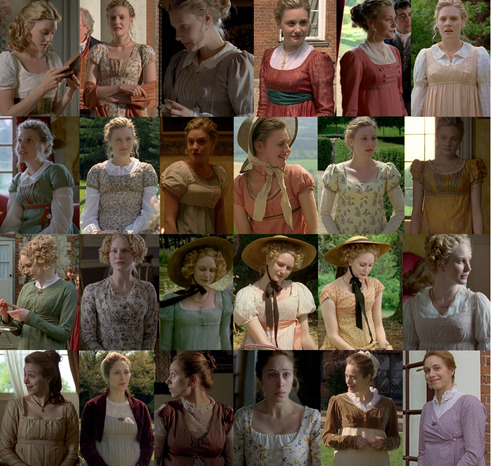
Emma’s daywear is full of warm and muted colors. Salmon and magenta are commonly seen. I love that most of Emma’s daywear consists of sleeveless or short-sleeved gowns with wide-sleeved linen blouses underneath. It’s not a commonly seen aesthetic so it feels light and fresh. My favorite of Emma’s daywear dresses is the pale yellow with purple floral print.
There’s one other in particular that I love.
Emma’s blue, sleeveless dress. I love this because of HOW OBVIOUSLY it’s a reference to this portrait of Charlotte, Princess of Wales. I mean...
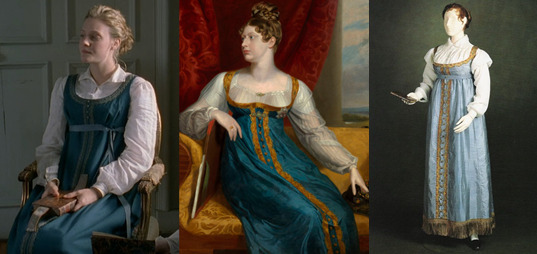
I’M NOT IMAGINING THIS, RIGHT? WHY DOES NO ONE TALK ABOUT THIS? This is a REAL dress. They still have this exact gown of Princess Charlotte’s. It’s on display. It’s faded, but it’s the same dress.
Harriet has a fresh and innocent green, white and purple color scheme with healthy doses of peach and pink showing. I particularly like her white and purple floral print dress.
Mrs. Weston’s color palette varies, but leans heavily on tans and purples, which is very flattering, I must say, to Johdi May’s coloring and is really refreshing for Mrs. Weston who seems to get stuck in pinks and yellows a lot. No idea what’s going on with the laced-front dress though? This doesn’t quite read as authentic to me, but I do like that her first dress seems to be an apron-front.

I know I already said that this is the worst Jane Fairfax Blue™ offender, but guys I can’t stress it enough. WE ARE 5/5 ON DAYWEAR HERE. LOOK AT THAT. (Also of note, Jane 5 is one of Gwyneth Paltrow’s dresses from the '96 Emma.)
Mrs. Elton seems, at all times, to be wearing some form of pink, but I think I’m right in saying that the white day dress with the rose patterned bodice under the yellow and pink spencer is one of Jane’s dresses from P&P ’80. Can anyone confirm that? They did sneak in some Mrs. Elton Orange™ though, for Box Hill, and it’s worth noting that Mrs. Elton is the only lady who’s appropriately dressed on that occasion.
Isabella gets some understated day gowns that are very nice and also VERY “Jane Austen” in the sense that I feel like Jane Austen herself might have worn them.
Miss Bates, unfortunately is slapped with brown at just about every turn, but at least her “Nice” day outfit has some subtle leaf patterns, which is refreshing. Also Mrs. Goddard has a slappin’ cap. Love that.
Also, Harriet’s Grecian costume for the painting (upper right hand corner). What can I say, but that I love it. I love that it hints at the neoclassical influences on Regency fashion too. This is my favorite interpretation of the painting too.
Evening Wear

You know what I love about this version? It’s the first version of Emma where her gown for the Crown in Ball isn’t WHITE. I know, I know white was fashionable, but it’s just… it’s nice for not EVERY gown in a ball scene to be plain white friggin muslin and also, it’s not one she’s ever worn before, which is great.
Harriet does have only white evening gowns but that’s okay. My only complaint is that, specifically on her Crown Inn dress and in a lot of her costumes in general, the waistline seems just a little low. Hmm. I really like the pale blue pattern on her first evening dress though.
Mrs. Weston though. Woo. Look at those. She has a dark chartreuse gown with black lace trim that any other version would have put on Mrs. Elton, so you know from the dark tones that she’s a bitch. Not so with Emma '09, and that’s good. And her teal dinner number is a favorite of mine. I never paid much attention to her green and gold ball gown but it has some really beautiful, subtle leaf or maybe peacock feather patterns on it and I love that. My only problem is that there seem to be some fit issues. She’s got muffin top way too often. Her orange evening dress is a bit of a dud though, firstly, because it has long sleeves (which is an evening gown no-no) and the fabric slaps a bit too much of sari fabric for my tastes.
Jane, not only is put in blue with both of her evening gowns (although one is so pale it borders on white), ONE of them is another Emma ’96 repeat and not only that, it’s one of Jane Fairfax’s dresses in that film! Perhaps that’s enough to make it an homage, and I have to say, I think Laura Pyper wore it better.
Miss Bates only has one evening wear ensemble, but at least it’s cream and not brown.
Mrs. Elton’s gowns are surprisingly understated, and yet still seem to be annoyingly fussy and, what’s better? They’re not sickly green. One of them is actually a very pleasant mint.
Outerwear
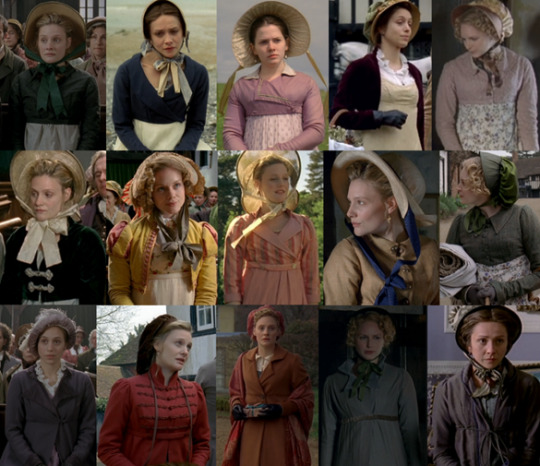
Outerwear is roundly pretty great here. Emma’s primary choice of color for spencers is emerald/evergreen and one of them is Elizabeth’s Bennet’s from the 1995 P&P (though to be honest, I think Jennifer Ehle filled it out better.) I do love Mrs. Elton’s pink and yellow number with the slashed sleeves. Jane Fairfax’s only spencer is, you guessed it, blue, but her friend Miss Campbell has a rather fun mauve one.
There’s no shortage of pelisses and redingotes either. Harriet can be seen in one borrowed from Elinor Dashwood in the '08 S&S, Mrs. Weston has a rather fabulous purple one which she wears with the most delicious looking hat I’ve ever seen.
Emma has two. The first one is a great magenta number with military braiding (and I think she wears with it one of the brown slouch hats that Kate Beckinsale wore in the same role) and while the other pelisse is brown, they had the sense not to make her wear a hat with it that was also brown. Instead, they gave her a contrasting color. Good on ya, Rosalind!
Speaking of hats, I don't often single them out for commentary, but I want to here because… the hat authenticity is… kinda spotty. Let me show you.
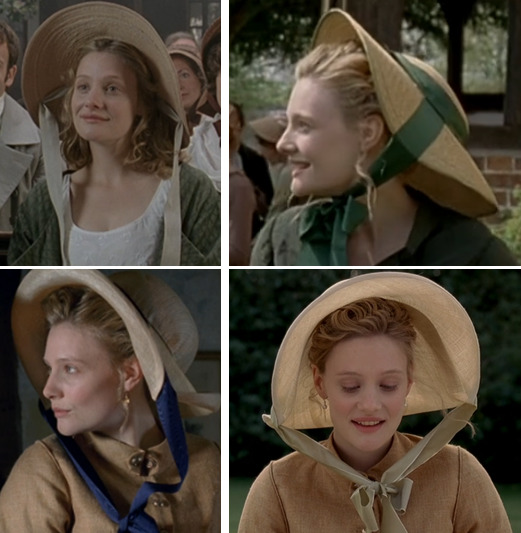
Okay first of all, Emma may be a teenager in this pic on the upper left, but she is not dressed formally enough for her sister’s wedding (which is what’s going on in this scene) but at least her hat is pretty good. You can see the ribbons are on the inside of the hat here, which is as it should be… but she never wears this hat again. At any point in the series. Instead, we next see her in the one on the upper right and ye gads this is atrocious. WHY IS HER HAT NOT PINNED ON? IT’S SLIDING DOWN THE BACK OF HER HEAD. SOMONE FIX IT. PLEASE. But wait, there’s more. This kills me because these bottom two are so similar to the one she wore earlier (the correct one) but crappier looking. Jeez.
This is not a hat. It’s a peanut. You know who doesn’t have this problem? Harriet. She only has one sun hat but at least it’s correct.
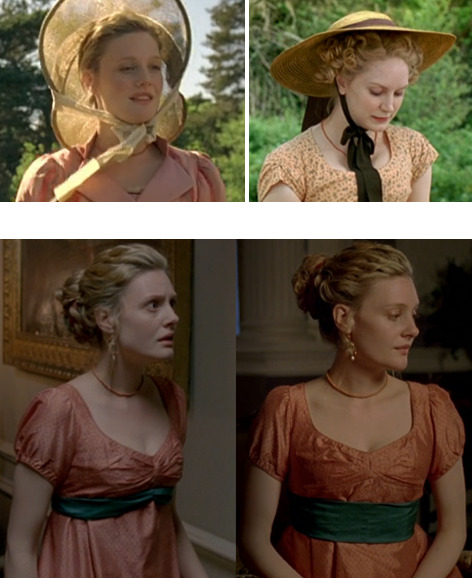
I also wanna touch briefly on this ^ costume continuity issue.
WTF is this? She’s in the hall, her ribbon is contoured to the line of her dress; she goes into the drawing room and… it isn’t anymore? Wha happun?
I took more menswear screencaps for this version than any other version. And that’s because the men just have more outfits that are, y’know, different from each other.
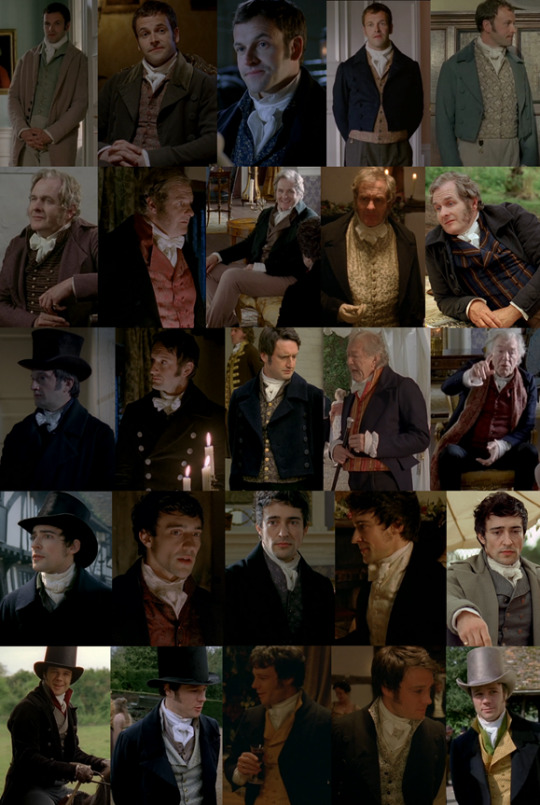
Mr. Knightley is as understated as ever, but I wanna highlight the first pic there and why I love it. This is Knightley’s first appearance in the series and it’s the perfect establishing shot that shows the viewer everything they need to know about Emma and Knightley’s relationship and how it has always been. He sort of materializes, out of focus in the background, but Emma immediately knows he’s there. And to accentuate how much Knightley is part of her home and scenery, his clothes (similar shades of pale tan, white and minty green to the wall behind him) almost camouflage him and make him seem at one with the moulding.
He also has a rather lovely blue evening waistcoat that I WISH I could have gotten better shot of (although I do believe it’s also worn by Henry Crawford in the '07 Mansfield Park, so for further reading…)
Mr. Weston finally gets to wear clothes that aren’t all brown! He only has ONE brown outfit. He gets PATTERNED waistcoats, one of them a rather spiffing blue and brown striped number. And he wears TROUSERS! Because he’s a gentleman, and he’s not that old and trousers are worn by fashionable gentlemen in this period!
You know who else gets to wear trousers and at least one fun waistcoat? Mr. Woodhouse. Check out that lovely Sunday Best™ waistcoat. The red striped one. That’s delightful.
John Knightley’s evening wear intrigues me. That’s a double-breasted jacket, and you know I’m not totally sure that’s very authentic for evening-wear of this period, but it is different. Unfortunately he also has a flared top hat and that is definitely not on for this period.
One of my favorite things about this version is that they don’t dress Mr. Elton as a clergyman all the time. Yes, he may be the vicar, but he’s also allowed to dress like a fashionable, handsome young man. So I’m really happy that he gets to flex his fashion muscles here.
And speaking of fashionable young men, FINALLY frank gets to be COLORFUL and his trousers are even tight enough. Both he AND Elton are often seen wearing TWO waistcoats, as I would expect them to, and even though Frank’s a dandy, he knows that flashiness is gauche so his pops of color are bright, but not in your face. His green and red waistcoats are always worn under more muted colors, and I just love it.
The only problems are… what’s with the turned-down waistcoat collars? There’s no precedent for this, in fact I think it’s directly contradictory to the style at the time, and also it makes the cravats look a bit unruly.
A Critique of Manners
A lot has been said about the manners in this adaption. Like, the actual manners, body language and facial expressions, specifically vis-à-vis Romola Garai.
And, oh yeah, there’s a lot to pick at here, but first I’d like to talk about the facial expressions.
I'm mostly gonna be talking out of my ass here, but this is my take, so if anyone can make a better argument against my points, I am listening, because I don't really like talking out of my ass and I like to be informed. That said...
I tend to be lenient on the… exaggerated facial expressions because, something I’ve noticed reading Austen’s works through the last several months is that Austen is very descriptive when it comes to facial expressions and I just find it hard to believe that people in the Regency Era never made exaggerated expressions like this.
I’ve heard a lot about how Garai’s Emma is not dignified or lady-like. But let’s think about the context of Emma Woodhouse – she’s never been in society. She’s only had a governess to teach her, and we know Emma’s always been sort of averse to being told what she can and can’t do. Emma is the highest ranking woman in her social circle (barring Isabella’s occasional presence). Emma doesn’t have to be ladylike. At 21, she’s already her local Lady Catherine. She puts a lot of stock in her position in society but, as Mrs. Elton will be the first to hypocritically point out, she’s very poorly behaved. I'd be very curious to see what would happen if Emma went to London for the season. Probably, she'd be seen, comparatively, as a country bumpkin. Can you imagine how she might get on in a sea of accomplished young ladies? She can barely handle having ONE rival with any kind of grace.
Austen never describes bodily movements of the kind we’re looking at when we watch adaptations, so why not have Emma’s body-language be un-ladylike in the conventional sense of the time? I’m not saying this to excuse the absolutely inexcusable (Frank’s head in her lap, kneeling on the sofa backwards etc.), but while Emma’s mannerisms aren’t exactly ladylike for her time, they’re not overtly masculine either (which was one of my biggest problem with Death Comes to Pemberly for example.)
Yes, there’s an ideal for manners. But we know real people didn’t always follow those ideals. In dancing for example, many dancing guidebooks of the day were full of repeated instructions not to be too loud or rambunctious when dancing. What this tells us is that people were doing just that, and probably quite a bit, too. I think that, while taking societal strictures into account, we shouldn’t totally discount the idea that people in the Regency weren’t really that different from us, and young people especially.
Now I’ve already mentioned some of the inexcusable aspects of interaction in this adaptation and they’re so notorious at this point, I don’t think that I really need to go over them much here. Although I will say: is it ridiculous to have Frank Churchill put his head in Emma’s lap? Yes. Did it make me more viscerally uncomfortable with the situation on Box Hill than any other version? Yes.
I was like, 14 when I watched this the first time. This was an effective way to telegraph to young people like me that Emma is being extremely inappropriate here in a way that no other version really managed to, even when I watched them when I was older and understood the period more. I’m far more acquainted with Regency manners than I was then, but to be honest – if they had been accurate with the manners here, when I was 14 I would not have understood what the big deal was. Is there merit in circumventing historical accuracy in favor of reaching a less-informed but still-interested audience? Yes, I think so. There were three other versions of this, at that point, that did this scene with more or less pristine manners. Not every version has to follow the manners of the time to-the-letter to be good. That’s my feeling on the matter.
There are things that do really bother me though. Like the idea that Harriet Smith doesn’t know how to spoon soup, for instance. As I said in my review for the Miramax version, table manners are pretty basic, there’s no reason Mrs. Goddard wouldn’t have taught Harriet this. It does provide a good moment to show Emma tacitly coaching Harriet and showing the trajectory in which this relationship will go, but personally I don’t think it was necessary—there are plenty of other ways that could be done.
Also: kids at the dinner table? I know this is part of building the familial atmosphere but it really does annoy me, because apart from building the familial atmosphere (which they do very well and frequently in other ways) it really didn’t need to happen, and it doesn’t add anything.
The Heart of Highbury
So, as I’ve hinted at throughout this review, the bread and butter of this adaptation of Emma is emotion. This version goes hard and heavy on showingthe relationships – Emma’s relationships with Mrs. Weston, Mr. Knightley, her father, her sister, her brother-in-law, Miss Bates; Jane’s relationship with Frank; Frank’s relationship with his father; The John Knightleys’ home life – and it illustrates things that can be surmised from just reading the story, but really draws your attention to them in ways that other adaptations just don’t.
It does this from the very beginning with the prologue which explains in detail (not just in quick exposition between characters) how Jane and Frank were separated from their families at young ages. We know now, from psychological study, that being taken away from their primary caretakers during their formative years is one of the most psychologically traumatizing things for a child. This is deeply important context which is explained in detail by the narrator in 2-3 large pages (in my Barnes & Noble anthology) in the book.
In the featurette on the houses, they talk particularly about Hartfield and the Woodhouses being the heart of Highbury and how they particularly wanted it to feel homey because Hartfield is Emma’s house and they wanted the audience to feel why everyone is so drawn to it, and to Emma; to me that is what they did with the whole adaptation in microcosm.
I usually talk a bit about the dancing and I'm going to here as well because this is maybe the most special dance scene in any Austen for me. Of course I'm going to link to Tea with Cassiane as usual because she knows what she's talking about and I don't. But I wanna add some comments. She gives this a pretty low rating in spite of a generally favorable commentary because of two big oopsies, the circle dance formation is one, and the other is I believe, an issue with the style of dance not matching the tune in Emma's dance with Knightley. Throwing out any objective technical analysis though, this is my favorite Ball in any Austen and it all comes down to the cornerstone of this adaptation--emotion.
All of the songs and dances were original compositions and choreography made for this adaptation. So they're not period per se, but the tunes at least are representative of how Regency dance music should sound. These dances are upbeat, and lively and, damn they look like fun. Everyone is excited here and it makes me understand why dancing was such a big thing. Best of all that excitement adds to the emotional charge of the scene. "The Ship's Cook" is the most fast paced dance and I'm glad they made this the dance where Elton snubs Harriet because it really hits for me just what Harriet would be missing out on if Knightley wasn't so fucking aptly named. In all other versions you get the insult, but the dance that's taking place is usually a Baroque walker so it doesn't seem terribly like she's missing out on much. Here, this is like not getting picked for kickball-- not only is it a slight that no one wants you on their team, but you miss out on even playing the game. Harriet looks so lonely, and her feeling of being out of place rolls off of Louise Dylan so forcefully it chokes me up just thinking about it because I've been there, man. I feel this shit. *dabs eyes*. Ahem. So, yes, when Knightley engages her for the dance the excitement the viewer feels is that much more forceful and Harriet's exuberantly starting to jump in when the timing is off and Knightley gently pulling her back, it just hits me in the feels center, guys. (I wanna take a moment to give a shout out to every camp counselor who ever partnered with me for any game at summer camp.) Emma's reaction too, is gold. Her genuine relief at Knightley swooping in is one of those great reminders that Emma is Harriet's friend, and she does care about her.
Finally on the dancing front, I wanna talk about Emma's dance with Knightley and why I prefer it to the one in the 2020 version. I already talked about this a bit in the 2020 review, so I'm gonna try and keep it brief. That shouldn't be too hard, because I'm probably mostly going to repeat a lot of what I've already said about Emma and Knightley in this version as a whole.
The big thing everyone loves about the Crown Inn dance in the 2020 is the yearning, the sexual tension, the quivering touches etc. Don't get me wrong, I LOVE all of those things but... not all the time. Not in everything, and definitely not in Emma. Because Emma, to me, isn't about repressed sexuality or heated tension or seething passion. Emma and Knightley are the opposite of that, to me, really. One of my mutuals put it best, I think: "Emma and Knightley are more suited to stolen glances than hot touches."
In Part 1 I talked about how Knightley is Emma's comfort object. When Emma is out of sorts, Knightley re-centers her. It helps set up, and puts emphasis on, the crisis of the story in the last act--Emma not knowing what she has until [she thinks] she's lost it. Emma and Knightley are Friends to Lovers done as it should be. She is already so comfortable with him she doesn't even realize her own feelings. She just feels right with Knightley and that's what this dance is here to show you--a foreshadowing of matrimonial harmony.
The dance itself, of course, is always up to interpretation, because Austen never describes how it goes, just that Knightley asks Emma to dance and Knightley doesn't dance (barring charitable causes). If you prefer the sexual tension take, if that, to you is an improvement on Austen's story and gives you what you've always felt was missing, I'm glad that there is a version now that gives you what you've been looking for, but for me, I think the 09 approach hits closer their dynamic in the book.
Now do I do think the Emphasis on emotion maybe went a little too earnest in some places in this adaptation? Maybe. Just a little.
In my last review (1972) I went on a rather lengthy tirade about the scene where they turn Emma’s appeals to Harriet to exert herself and move on following Mr. Elton’s marriage into Emma guilting Harriet into thinking she’s a bad friend for being heartbroken and then throwing her into the situation most likely to rub salt in that particular wound.
In this version, while I love the emphasis they put on the stress Emma puts on her own guilt for being the reason for Harriet’s situation in the first place, I think it’s maybe a little too… much.
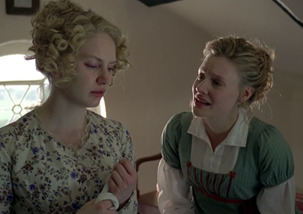
That’s the only way I can put it. I know I’ve just said that I think there should be a bit more expressiveness in period drama, but this doesn’t quite match the way I read it (Emma’s a bit less desperate in Austen’s prose. Very dedicated to helping Harriet feel better, but just a skosh more composed). I think she’s even crying in this scene.
While we’re here let’s go over to Box Hill ONE. MORE. TIME.
First of all, this is where this screenplay shines, in my opinion. This is the big turning point in the story and as such, should be a touchstone for the judgment of any adaptation. This sequence in the 2009 version is a perfect crystallization of everything I love about this version—namely that this is the version that, to me, most feels like someone read the book thoroughly, paid attention to what Austen was describing and then actually tried to convey it on screen. A lot of other versions sort of feel (to me), like the director glanced at the page and said “here’s what I want to convey in my version”. Insofar as making a piece of art goes, that’s good. Directors are artists as much as painters are and movies are their canvass, but it’s seldom that you find a director who honestly wants to hit as close to the author intent as possible and this Box Hill sequence makes me feel like that’s what Jim O’Hanlon was going for. I have the book open next to me as I write this and it’s shocking to me how minutely the atmosphere described in the book is conveyed here. Most of all, the fact that Emma’s insulting Miss Bates is not the only thing faux pas she makes here. Box Hill as a whole is a disaster, and it’s largely because of Frank.
“When they all sat down it was better; to [Emma’s] taste, a great deal better, for Frank Churchill grew talkative and gay, making her his first object. To amuse her, and to be agreeable in her eyes, seemed to be all that he cared for—and Emma, glad to be enlivened, and not sorry to be flattered, was gay and easy too, and gave him all the friendly encouragement, the admission to be gallant, which she had ever given in the first and most animating period of their acquaintance; but which now, in her own estimation, meant nothing, though in the judgment of most people looking on it must have had such an appearance as no English word but flirtation could very well describe. “Mr. Frank Churchill and Miss Woodhouse flirted excessively.” They were laying themselves open to that very phrase—and to having it sent off in a letter to Maple Grove by one lady, to Ireland by another. Not that Emma was gay and thoughtless from any real felicity; it was rather because she felt less happy than she expected. She laughed because she was disappointed…” --Emma, Chapter 43
Most other versions rush through Frank’s “excessive” flirting with Emma (Right in front of Jane) to get to “Three Things Very Dull Indeed” as fast as possible, and yes that’s the crowning horror of Box Hill, but there’s a very intricate setting here, too, and this version has the time to lay back and let it all unfold in the oppressive discomfort of an English summer day.
Even better than all of that though is Knightley confronting Emma after it all goes down. This treatment is neither plaintive, nor aggressive as it was in ‘96 and ‘97 respectively. I’ve already extolled the virtues of Johnny Flynn’s Box Hill rebuke, but for a change I’m not going to zero in on Miller’s performance which is, at least as good as Flynn’s, but on Romola Garai’s, which I find superior to Anya Taylor Joy’s. Specifically, her reaction once she’s alone.
ATJ in the 2020 version immediately breaks down sobbing and it’s hard for me to feel that she’s sobbing for “anger against herself, mortification, and deep concern” or that there’s much self-reflection going on there. To me it rather just feels like she’s crying because she got shouted at. The theatrics of it, to me, feel childish and self-centered.
I don’t feel that with Garai’s performance.

“She was vexed beyond what could have been expressed—almost beyond what she could conceal. Never had she felt so agitated, mortified, grieved, at any circumstance in her life. She was most forcibly struck . . . How could she have exposed herself to such ill opinion in anyone she valued! And how to suffer him to leave her without saying one word of gratitude, of concurrence, of common kindness!
Time did not compose her…” --Emma, Chapter 43
Of course one can make the case that Emma's reaction should be a bit childish because Emma is an immature character, but that's the thing--I can agree with you anywhere else in this story but this is Emma's maturing moment. This is her turning point as a character. It's where we should see her reactions shift from the same childish denial we're used to seeing when Knightley scolds her, because this is different. It's not the usual brushing off of big brother Knightley, this is a young woman reacting to an esteemed friend pointing out how abhorrently inappropriate she's been and her having to admit that to herself.
I didn't really want to drag comparisons to the 2020 film into this, not on this scale at least, but this just jumped out at me the last time I watched the new film and I have to express it somewhere.
What I see in Garai’s performance is desolation and mortification. That shocked tearfulness of knowing you’ve been justly reproached for wrongdoing, but being too frozen in a pretense of composure to actually cry about it until you’re quite sure that no one will see you. And especially when it’s someone you esteem rebuking you, the horror of them leaving before you can admit that they’re right. There’s so much more depth here, I think, and I can’t even quite express what it makes me feel.
The aspect of time not composing her is another thing that they decided to put stress on in this version. Emma looks fucked up in the following scenes. When she goes to see Miss Bates, she clearly either hasn’t slept or has slept very badly. I feel like this is maybe an anticlimactic conclusion to this section but I’m afraid I’m very close to reaching incoherence, so I’m just gonna leave it here.
My absolute favoritest thing about this version though—something that sets it apart from ALL other versions and even adaptations of other Austen stories—is the inclusion of the post-confession conversation.
This is something of a trope in Austen books but it very rarely finds its way into adaptations: confessions of love are out of the way, the hero and heroine settle into an easy an comfortable conversation, glowing with happiness as they explain and laugh over their actions and misinterpretations of each other’s choices. It happens in Pride and Prejudice, in Persuasion, and yes, in Emma. This is the only Austen adaptation, that I've seen, to include this kind of conversation in any kind of detail. The 1995 Pride and Prejudice alludes to the corresponding scene in it its source material, but the lines pulled from it get tossed into the confession scene itself and then it flies through to get to the obligatory wedding—a side effect of rushing through endings, a convention I’m rather tired of.
Emma (2009) takes its time with this, as with all other aspects of this adaptation. For a version that’s so full of energy, its pacing is extremely laid back and comfortable, without dragging. When you hear the gentle musical swell and Emma and Knightley have their kiss (this whole confession sequence is so sweet and wonderful in its own right), you expect that to be it. But no, we cut to them, the picture of contented happiness, sitting together on a bench overlooking Hartfield’s garden, just talking and enjoying being together, with no teasing, no pretense. If Jane Austen stories emphasize anything, it’s the importance of communication in relationships, and I think that’s maybe why she made it a point in almost every story to show her characters communicating their feelings in words, even after all the conflict has been resolved. This is my favorite scene in the whole series (In case it being my header image didn’t make that obvious.)
This is followed rather promptly by a cut to the next day, with Emma bursting in to Donwell in hysterics about how they can’t be married because she won’t leave her father alone.
This is one of those maybe over-the-top choices that a lot of people don’t like, but guys, it was so funny to me when I was fourteen and it still makes me laugh. It might seem outlandish, but to me it’s just the emphasis on personal relationships and emotion coming through again and it always makes me smile.
Final Thoughts
It’s hard for me to give a proper round up of my feelings for this section because I think I’ve poured just about all of my feelings on each aspect into its dedicated sections.
At the end of the day, the only thing that really disappoints me about this version is the number of missed opportunities there are here. One of my favorite parts of reading Austen is when I run across a line in dialogue or narrative that just… slaps. But they never make it into the adaptations. Emma is full of them and I just wish that Sandy Welch could have taken an opportunity to slip a few of them in.
In summary, I think this is a wonderful, heartfelt adaptation aimed at getting to the emotional heart of a story that often gets caught up in the Mean Girl-ness of its main character than the coming of age story that it is. It's one of my favorite period dramas because it's one of the few that really captures the spirit of the source material as it's always felt to me. There's really only two other period dramas that I esteem on the same level as this, and they're North & South (2004) and Jane Eyre (2011) and it's for the same reasons; because they impact me deeply on an emotional level--which is what art is supposed to do--because of how well it captures the essence of the story that I know and love.
So did I succeed in a more objective review of Emma 2009? I' feel like probably not. But I tried my best. It’s so hard to be objective about something that makes you as happy as this adaptation makes me.
Ribbon Rating: Most Agreeable (83 Ribbons)
Tone: 10
Casting: 9
Acting: 9
Scripting: 7
Pacing: 10
Cinematography: 7
Setting: 9
Costumes: 6
Music: 8
Book Accuracy: 8
#emma 2009#emma woodhouse#mr. knightley#jane austen#jane austen emma#romola garai#jonny lee miller#period dramas#regency
40 notes
·
View notes